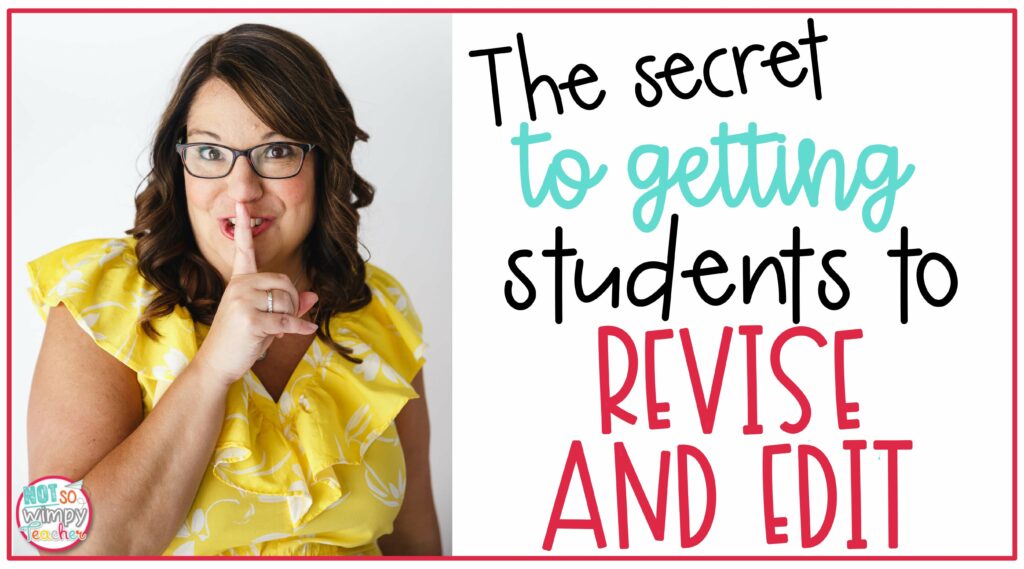
One of the most common questions I hear from teachers is, “How do you get students to revise their writing?”
At first, this question stumped me. I didn’t have a special plan or strategy to encourage kids to revise. I just made it part of my writing process.
Each day, I taught a mini lesson and told my students to practice the skill we had just learned during their independent writing. And luckily, they did it.
I never made a big deal about the fact that we were revising. I just had my students apply each mini lesson to their own masterpieces. And, over the course of a few weeks, they revised their work.
But the more I thought about it, the more I realized I did have a secret that made kids not just willing but eager to revise their work.
And today, I’m going to share that secret with you. Are you ready?
Start Writing Right Away
I let them start writing right away. Yup, that’s it. It’s that simple.
Rather than making my students wait until I taught them everything there is to know about opinion writing (as if that’s even possible), I’d teach them one little thing and then send them off to write.
This means that their first draft isn’t going to be perfect. They won’t know all the things they are supposed to know to craft persuasive essays. But that’s okay. Perfection isn’t the goal of the first draft. Or even of the final copy.
But because the students have had the opportunity to write about something that matters to them, they are invested in the writing process. They want to make their work better. And by teaching specific mini lessons, it’s easy for them to practice new skills. They are more likely to take their time revising and editing to make their work better.

Writing Is a Process
A long time ago, I saw the quote, “You can always edit a bad page. You can’t edit a blank page.” (Jodi Picoult). I’d substitute the word revise for edit because they aren’t the same thing (more on that later), but that quote has always resonated with me.
I decided to incorporate it into my teaching. I taught my student that the most important thing during the drafting stage is simply getting your ideas on paper. You don’t have to worry about spelling and grammar or even details, descriptions, or word choice. There is time to add all of these things later on.
The students write the first draft quickly, usually in just a couple of days. Then they move on to revising. And, after that, editing.
Revising and Editing
When I first started teaching, I didn’t understand the difference between revising and editing. I didn’t know why they were two separate steps in the writing process. But now I know these steps are very different.
Revising
Revising is everything we do to make the writing sound better. It happens immediately after drafting and makes the project more interesting to read.
Examples include:
- Adding details and dialogue
- Developing characters
- Making the lead more interesting
- Adding examples to support your reasons.
Revising is the MOST important part of the writing process. It’s where you add all the features that engage readers and make them keep reading.
Revising takes a long time. Often 4 or 5 weeks. But most of the time, students don’t even realize they are revising. They are simply applying the skills from the mini lesson to their own writing. Each time they add a new skill, their writing gets stronger.
Editing
Editing is what we do to make the writing look better. It happens after the story is nailed down and well-developed. In fact, it’s the last step in the writing process right before publishing. It includes things like:
- Correcting spelling
- Adding punctuation
- Checking grammar
- Capitalizing letters
It’s important to provide resources to kids to help them edit. Things like textbooks, dictionaries, word walls, and anchor charts can help. But don’t give kids all these things at once. Just pick one at a time.
It’s also a good idea to break up the editing process. If you tell kids to edit their writing, they usually look over it for about ten minutes (okay, two is probably more accurate) and then hand it in, saying everything looks good. In two seconds, you immediately see ten errors.
It can be overwhelming for kids to look for all the errors at once, so it’s helpful to break editing down into a multi-step process as well. On the first day, you might suggest they check punctuation. The next day they can look for spelling mistakes. And so on.
Make it Easy to Revise
Because students spend so much time revising and editing their work, there are bound to be lots of changes. Their manuscripts are going to get messy. This is a good thing. But it’s important to be prepared for it.
Students will need a place to write all their changes. And you definitely don’t want them to have to rewrite every time they revise. Instead, set kids up for success by showing them exactly how to set up their papers to make revisions easy.
I tell students to:
- Skip lines. This makes sure this is plenty of space to rewrite or add sentences. It’s a good idea to have them place an X on every other line so they remember not to write there.
- Leave 1/3 of the page empty on the right-hand side. This provides additional space for additions.
- Only write on the front. This provides enough space for big revisions, like adding entire paragraphs.
It’s also important to give students a simple strategy for adding text.
- Show them how to use carrots, arrows, and even numbers to show where the new text fits in.
- Use colored pens or pencils to help revisions stand out.
That’s all there is to it. I get my students to revise by making it super simple. I model one skill at a time and then give students a small revision task using that skill. Most of the time, they don’t even realize they are revising. But their writing keeps getting better and better.
FREE Editing and Revising Centers
Want to make editing even easier? Check out my FREE Editing and Revising Centers!
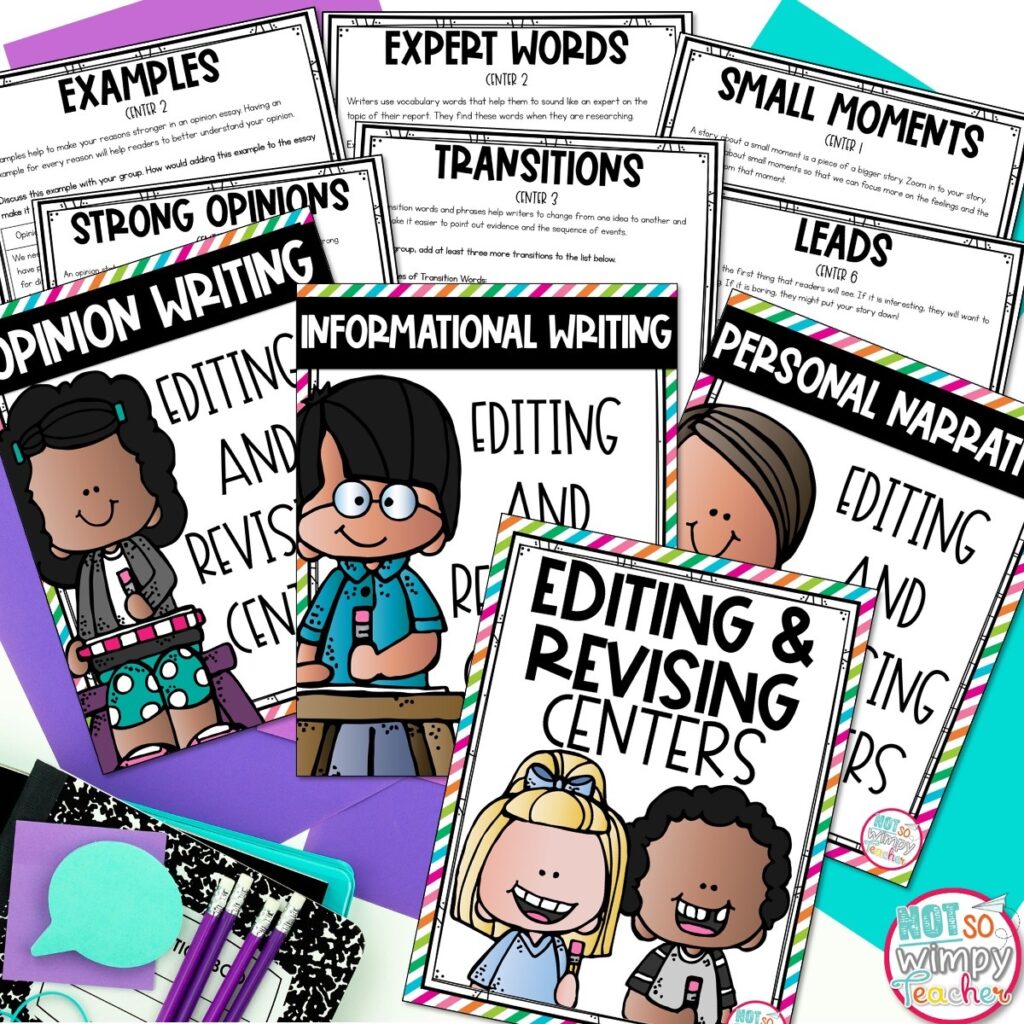
This resource includes centers to help your students master tricky editing and revising skills.
Inside you’ll find:
- 18 hands-on centers, each focused on one specific skill
- Differentiated activities for grades 2-5
- Narrative, opinion, and informational writing tips, examples, and practice activities
- Editing and revising checklists
- Detailed teacher directions and center signs
These centers make a great review activity! Divide your class into groups and let them work together to read the tips, review the examples, practice the skill, and discuss their ideas.
I know you and your students are going to love them!
If you’re looking for more tips on teaching writing you might like How to Plan an Entire Year of Writing Lessons, How to Teach Writing When You Don’t Have Time, or 5 Things You Don’t Have to Do When Teaching Writing.
Work With Me
And, if you want more tips on how to make teaching writing easier, you’ll love my Not So Wimpy Writing Masterclass. I specifically developed this online professional development course for teachers in grades 2-5 to help simplify writing workshop and provide the tools and strategies you need to be a more confident writing teacher.
You’ll learn tried and true strategies for how to teach writing, including how to:
- Teach writing in units
- Create manageable mini-lessons
- Keep students on task during independent writing time
- Implement a successful writing workshop without chaos and confusion
- Transform ALL your students into eager and excited writers who have the skills needed to perform well on standardized tests
In short, this course is designed to help you become a more confident writing teacher, regardless of what writing curriculum you have (or don’t have). And the Masterclass is so easy to take. It’s entirely online! You can watch whenever and wherever works best for you. And you get lifetime access to the course, which means you can return to the videos over and over again.
Registration for the Not So Wimpy Writing Masterclass is currently closed. Be sure to sign up for the Waitlist so you will be the first to know when we open it again. Sign up now so you don’t miss out!
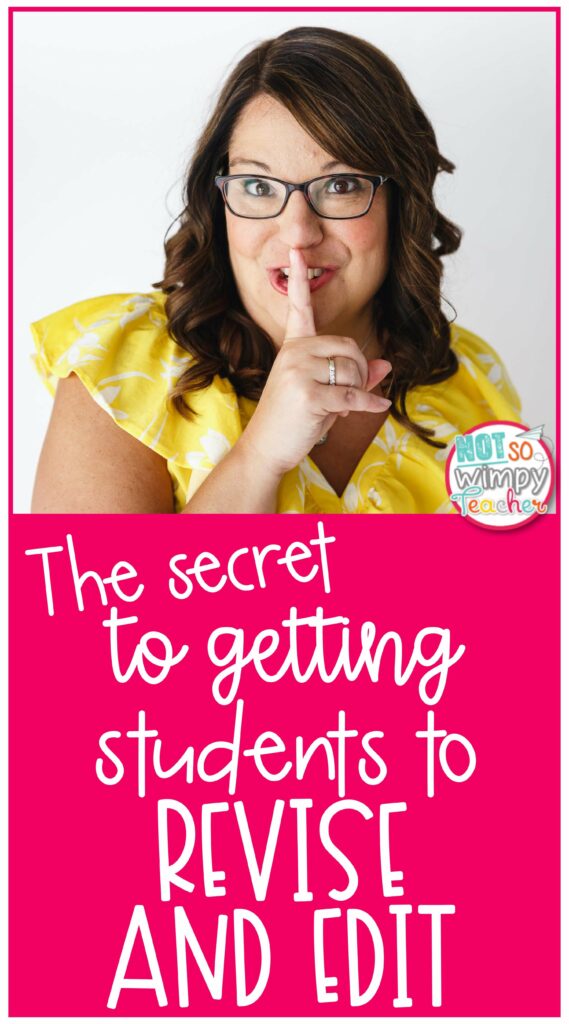
Have a Not So Wimpy Day!


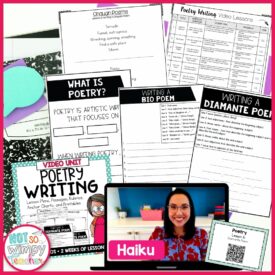



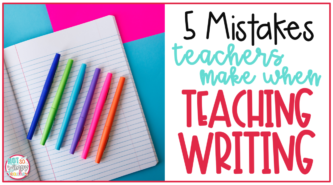
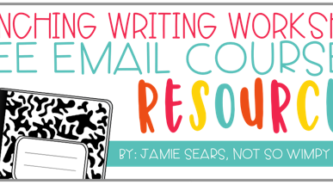












 End of Year Carnival Week for grades 2-5!
End of Year Carnival Week for grades 2-5!
Thanks! I love the idea of leaving a portion of the right side of the student’s pages empty for adding revisions– that was a new take away for me.
I purchased your Grammar Bundle for 4 & 5 some time ago……
It is always so great to check back with your enthusiastic help! I improve my process each time I listen.
Thank you!
Thank you, Sue. I’m so glad you continue to pop back in to revisit strategies.
I have just recently “found” you and I am so glad I did! I love everything I have read and watched so far. I purchased the 4th grade writing bundle. My next purchase is going to be the grammar bundle. I am excited to use them this upcoming year!
Welcome to the Not So Wimpy Teacher page! I’m glad you found me. Please feel free to reach out with any questions you have as you begin using the resources.
I recently found your page. This will be my 2nd year teaching 5th grade ELA. Last year I used our school’s program, Wit and Wisdom, and felt lost the ENTIRE year. I wish I had found you earlier. I am about to purchase the writing bundle for 5th grade, and I plan to purchase the grammar bundle as well. I have searched for a 5th grade pacing guide for ELA. Am I looking in the wrong place?
By the way, you ROCK!
Hi Nina,
I’m glad you are finding our resources helpful. At this time, I do not have a pacing guide all in one place for 5th grade. However, the bonus file in the grammar unit has a suggested order in which to teach the units and you can grab a writing pacing guide for free with this link: notsowimpyteacher.com/pacingguide